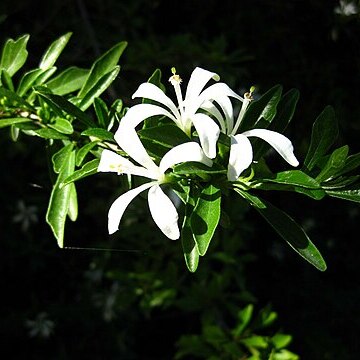Shrub 0.6-5 m high, sometimes scrambling. Leaves mostly in fascicles, lamina very variable, from narrowly oblanceolate and unlobed to cuneate-obovate and deeply lobed. Inflorescence: a 1-4-flowered axillary cyme. Petals pure white, narrowly spathulate, 25 x 3-45 x 5 mm. Ovary 5-locular, glabrous. Capsule 6 x 12 mm, depressed-globose, shallowly sulcate. Seeds 5.5 x 3.5 mm, bright red; aril small, white, fleshy, almost confined to the adaxial depression and not visible from the outside.
Leaves mostly in fascicles; lamina very variable in shape and size, up to 5 × 2·5 cm., usually smaller, oblanceolate to narrowly obovate, lower surface glabrous, apex subacuminate to emarginate, sometimes shallowly 3-lobed, base decurrent almost to the base of the petiole; petiole very short or absent.
Staminal tube 2·5–3·2 cm. long, cylindric, glabrous inside; appendages in pairs, alternating with the anthers, 1·5–2 mm. long, glabrous outside; filaments fused beyond the insertion of the appendages to form a short frill continuing the staminal tube.
Shrub, up to 5 m high. Leaves mostly fascicled, lamina up to 50 mm long, glabrous beneath. Calyx cup-shaped. Petals longer than 30 mm. Capsule 5-valved, thinly woody. Flowers white.
Ovary 5-locular, glabrous; style 2·7–3·3 cm. long; style-head broadly obovoid-cylindric, widest at the apex, exserted up to 3 mm. beyond the base of the staminal appendages.
Shrub up to 3 m. tall, sometimes scrambling; first-year branchlets puberulous with spreading hairs, second-year more sparsely so, reddish-brown or grey.
Capsule 5 × 10–13 mm., depressed-globose, shallowly sulcate, leathery, glabrous; aril vestigial, confined to the adaxial surface; testa red.
Inflorescence axillary, 1–3-flowered; peduncles 5–8 mm. long; bracts very small, 1 mm. long, subulate.
Petals 3–3·6 × 0·5 cm., linear to linear-spathulate, glabrous outside.
Calyx 3–5 mm. long, lobes pubescent.
Flowers pure white.


